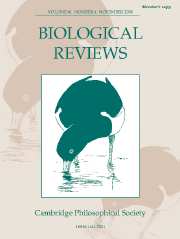Crossref Citations
This article has been cited by the following publications. This list is generated based on data provided by
Crossref.
Poulin, Robert
1999.
Speciation and diversification of parasite lineages: an analysis of congeneric parasite species in vertebrates.
Evolutionary Ecology,
Vol. 13,
Issue. 5,
p.
455.
Purvis, Andy
Gittleman, John L.
Cowlishaw, Guy
and
Mace, Georgina M.
2000.
Predicting extinction risk in declining species.
Proceedings of the Royal Society of London. Series B: Biological Sciences,
Vol. 267,
Issue. 1456,
p.
1947.
Purvis, Andy
Agapow, Paul-Michael
Gittleman, John L.
and
Mace, Georgina M.
2000.
Nonrandom Extinction and the Loss of Evolutionary History.
Science,
Vol. 288,
Issue. 5464,
p.
328.
Iwaniuk, Andrew N
Pellis, Sergio M
and
Whishaw, Ian Q
2000.
The relative importance of body size, phylogeny, locomotion, and diet in the evolution of forelimb dexterity in fissiped carnivores (Carnivora).
Canadian Journal of Zoology,
Vol. 78,
Issue. 7,
p.
1110.
Ashton, Kyle G.
Tracy, Mark C.
and
Queiroz, Alan de
2000.
Is Bergmann’s Rule Valid for Mammals?.
The American Naturalist,
Vol. 156,
Issue. 4,
p.
390.
Bininda-Emonds, Olaf R.P.
2000.
Factors Influencing Phylogenetic Inference: A Case Study Using the Mammalian Carnivores.
Molecular Phylogenetics and Evolution,
Vol. 16,
Issue. 1,
p.
113.
Heard, Stephen B.
and
Mooers, Arne Ø.
2000.
Phylogenetically patterned speciation rates and extinction risks change the loss of evolutionary history during extinctions.
Proceedings of the Royal Society of London. Series B: Biological Sciences,
Vol. 267,
Issue. 1443,
p.
613.
Flynn, John J.
Nedbal, Michael A.
Dragoo, Jerry W.
and
Honeycutt, Rodney L.
2000.
Whence the Red Panda?.
Molecular Phylogenetics and Evolution,
Vol. 17,
Issue. 2,
p.
190.
Bininda-Emonds, Olaf R. P.
and
Gittleman, John L.
2000.
ARE PINNIPEDS FUNCTIONALLY DIFFERENT FROM FISSIPED CARNIVORES? THE IMPORTANCE OF PHYLOGENETIC COMPARATIVE ANALYSES.
Evolution,
Vol. 54,
Issue. 3,
p.
1011.
Webb, Campbell O.
2000.
Exploring the Phylogenetic Structure of Ecological Communities: An Example for Rain Forest Trees.
The American Naturalist,
Vol. 156,
Issue. 2,
p.
145.
Rattenborg, N.C
Amlaner, C.J
and
Lima, S.L
2000.
Behavioral, neurophysiological and evolutionary perspectives on unihemispheric sleep.
Neuroscience & Biobehavioral Reviews,
Vol. 24,
Issue. 8,
p.
817.
Jones, Kate E.
Sechrest, Wes
and
Gittleman, John L.
2001.
Phylogeny and Conservation.
p.
141.
King, C. M.
Griffiths, K.
and
Murphy, E. C.
2001.
Advances in New Zealand mammalogy 1990–2000: Stoat and weasel.
Journal of the Royal Society of New Zealand,
Vol. 31,
Issue. 1,
p.
165.
Iwaniuk, Andrew N
Pellis, Sergio M
and
Whishaw, Ian Q
2001.
Are long digits correlated with high forepaw dexterity? A comparative test in terrestrial carnivores (Carnivora).
Canadian Journal of Zoology,
Vol. 79,
Issue. 5,
p.
900.
Alexandre Felizola Diniz-Filho, José
2001.
PHYLOGENETIC AUTOCORRELATION UNDER DISTINCT EVOLUTIONARY PROCESSES.
Evolution,
Vol. 55,
Issue. 6,
p.
1104.
Liu, Fu-Guo Robert
Miyamoto, Michael M.
Freire, Nicole P.
Ong, Phong Q.
Tennant, Michele R.
Young, Timothy S.
and
Gugel, Kikumi F.
2001.
Molecular and Morphological Supertrees for Eutherian (Placental) Mammals.
Science,
Vol. 291,
Issue. 5509,
p.
1786.
KEOGH, J. SCOTT
BARKER, DAVID G.
and
SHINE, RICHARD
2001.
Heavily exploited but poorly known: systematics and biogeography of commercially harvested pythons (Python curtus group) in Southeast Asia.
Biological Journal of the Linnean Society,
Vol. 73,
Issue. 1,
p.
113.
Purvis, Andy
CarDillo, Marcel
Grenyer, Richard
and
Collen, Ben
2001.
Phylogeny and Conservation.
p.
295.
Purvis, Andy
Gittleman, John L.
and
Brooks, Thomas
2001.
Phylogeny and Conservation.
p.
1.
BININDA-EMONDS, OLAF R. P.
DECKER-FLUM, DENISE M.
and
GITTLEMAN, JOHN L.
2001.
The utility of chemical signals as phylogenetic characters: an example from the Felidae.
Biological Journal of the Linnean Society,
Vol. 72,
Issue. 1,
p.
1.

